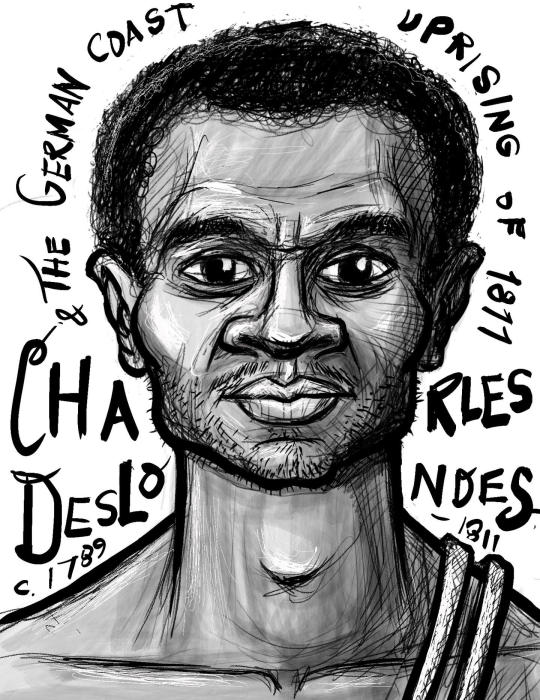#charles deslondes
Text
Today we venerate Ancestor & Hoodoo Saint, Charles Deslondes on the 212th anniversary of his passing. 🕊
(Updated 2024)

Deslondes was a Haitian-born brotha, believed to be from Saint Domingue, who was forced into the role of overseer on the Andry Plantation in Louisiana until he took up arms against them.
He was born on the Jacques Deslondes plantation around 1789. He was described as being as a “Creole mulatto slave by the name of Charles, “about 16 years old" & recorded to be a “field laborer.” Later, he was sold to the Andry Plantation of Col. Manuel Andre & forcibly worked as an overseer to 86 enslaved Afrikans.
Eventually, he organized enslaved Afrikans & maroons ahead of the legendary German Coast Uprising in what is now St. John the Baptist Parish, part of the German Coast off the Mississippi River.
On Jan 8th, 1811 Deslondes & 14 others attacked their slave "master" Andry Sr. (of the Andry Plantation in St. John's Parish) & killed his son. While Andry Sr. escaped, Deslondes & allies swept the plantation & fled into the Louisiana Territory. By January 10th their numbers swelled to 400-500. They successfully killed yet another slave "master", sending Whites from the area fleeing into New Orleans.
The governor of the Louisiana Territory assembled a militia of volunteers + 700 U.S. Army Troops & Navy Sailors to end to the rebellion after receiving intel on Deslondes' next move by the foolish few who betrayed Deslondes & Co in exchange for their own freedom.

"His hands were chopped off upon his capture; he was shot in both thighs and bullets were riddled throughout his body. Before he passed, his body was shoved into a bundle of straw and he was roasted alive as a warning to other rebels and "free" folks. [Later, he was decapitated & joined the heads of other rebels that were put upon spikes posted along major roadways throughout New Orleans.] - as described by the U.S. Navy.
We remember Deslondes for his unprecedented leadership & bravery that spearheaded the first & bloodiest rebellion on U.S. soil of his time. We remember him for his cleverness, courage, & heroism that inspired so many others to liberate themselves rather than beg for something that cannot be given by man. We remember him for his immeasurable suffering & for giving the ultimate sacrifice for the love of us.
We pour libations & give him his 💐 today. Offering suggestions: light a white candle, libations of water, & Haitian cuisine.
‼️Note: offering suggestions are just that & strictly for veneration purposes only. Never attempt to conjure up any spirit or entity without proper divination/Mediumship counsel.‼️
#hoodoo#hoodoos#atrs#atr#Hoodoo Saints#Hoodoo History#charles deslondes#the german coast uprising#german coast uprising#andry's rebellion#ayiti#creole#Louisiana#black history#thehoodoocalendar
141 notes
·
View notes
Text
Meet the sisters who purchased Woodland Plantation
Twins Jo and Joy Banners purchased the home where their ancestors were enslaved, which was also the location of Ameria’s largest slave revolt.
youtube
Growing up in Louisiana, in the bayous of the Mississippi River, identical twins Jocynita "Jo" Banner and Joyceia "Joy" Banner always heard stories from their grandmother Grace, who would tell them about their enslaved ancestors and their history of fighting back at the very plantation the two women now own.
"I know that she is really proud," Jo Banner said, referring to her grandmother. "She just served as this vessel to connect us to an energy that is informing and providing us the sustenance of what we need now for this fight."
The Banner twins are the founders of The Descendants Project, a nonprofit that fights for historic and cultural preservation for descendants of enslaved people. It was through their nonprofit that they bought Woodland Plantation, the birthplace of the 1811 slave revolt.
Raised on the West Bank of the Mississippi River, the twins were steeped in the tales of their grandmother, who recounted the harrowing events of the 1811 revolt known as the 1811 German Coast Uprising.
Often overshadowed in historical narratives, the rebellion saw the brave resistance of Charles Deslondes, two other leaders known as Kook and Quamana, along with approximately 25 others who sought freedom amidst the brutal oppression of slavery. They attacked on Epiphany Sunday. After injuring Manuel Andry and killing his son Gilbert, they armed themselves with more weapons and military uniforms.
The revolters walked through plantations on the east bank of the Mississippi River, along the River Road, and down the German Coast—through what is now St. John the Baptist, St. Charles, and Jefferson parishes— in an attempt to conquer the city of New Orleans, gathering as many as 500 more freedom seekers along the way. It became America’s largest “slave revolt”. By the end of the January 1811 rebellion, the white planters had brutally beheaded more than 100 enslaved men, put the rebels’ heads on spikes, and displayed them for 40 miles along River Road, from the center of New Orleans deep into plantation country. (Watch this video from CrashCourse with host Clint Smith III)
According to Britannica, “Even though the government and whites tried to minimize the uprising, surviving rebels and others passed down the stories, and Deslondes, Kook, and Quamana became legends among the enslaved people and their descendants.
Some 213 years later, Jo and Joy Banner became the newest owners -- and first Black owners -- of the historic Woodland Plantation site. It's the second plantation they've bought through the Descendants Project, the first being the Many Waters Plantation in Wallace, Louisiana.
The sisters said they purchase these lands to preserve their history -- they call it defensive buying. But they're also fighting for the freedom and protection of the historic homelands of their enslaved ancestors from industrial companies they claim are polluting the area, compromising the health of the land and the local population, a predominantly Black community.
"In addition to preserving that culture and aiming to get more recognition for that culture, we also do our best to protect the descendant communities, which are our descendant communities who are also fighting against a lot of environmental injustice, a lot of environmental racism," Jo Banner said.
Woodland Plantation is located on an 85-mile stretch of land along the Mississippi known as "Cancer Alley." Running from north of Baton Rouge to south of New Orleans, the area is surrounded by almost 200 industrial facilities releasing emissions linked to cancer in the region. Woodland itself is located in the most concentrated stretch, known as the "chemical corridor." Residents in this area have a 95% higher risk of cancer due to air pollution compared to the rest of the country, according to the Environmental Protection Agency.
The EPA announced last month that it was calling for the plants in this area to reduce toxic emissions linked to cancer.
In January, the international non-governmental organization Human Rights Watch singled out the state of Louisiana and the Louisiana Department of Environmental Quality, saying they had failed for decades to protect locals from industrial pollution and uphold federal safety standards, making the region the largest concentration of fossil fuel and petrochemical facilities in the western hemisphere.
About 20 minutes away from Woodland in Wallace, situated in St. John the Baptist Parish — and still in Cancer Alley — the Banner twins are also in a legal battle to stop a grain export facility from being built near their home and the Descendants Project headquarters. Read the full article here.
Source: ABC News, NOLA.com, The Drum Newspaper
Visit www.attawellsummer.com/forthosebefore to learn more about Black history.
Need a freelance graphic designer or illustrator? Send me an email.
#Woodland Plantation#La Place Louisiana#Louisiana history#Louisiana#Mississippi River#plantation#The Descendants Project#Black history#Black history facts#slave revolt#1811 slave revolt#Charles Deslondes#Kook#Quamana#Many Waters Plantation#Wallace Louisiana
3 notes
·
View notes
Text

youtube
The 1811 #German Coast #uprising was a #revolt of #enslaved#Africans in parts of the Territory of #NewOrleans on #January 8–10, 1811. The uprising occurred on the east bank of the #Mississippi#River in what is now St. John the #Baptist, St. #Charles and #Jefferson#Parishes, #Louisiana.
While the #insurgency was the largest in US history, the #rebels killed only two white men. Confrontations with #militia and #executions after #trial#killed 95 #black people.
Between 64 and 125 #enslaved#men#marched from #sugar#plantations in and near present-day #LaPlace on the #GermanCoast toward the city of New Orleans.
They collected more men along the way. Some accounts claimed a total of 200 to 500 slaves participated. During their #two day, twenty-mile #march, the men #burned#five plantation houses (#three completely), several sugarhouses, and crops.
They were #armed mostly with #hand#tools. #White men led by officials of the territory formed militia companies, and in a battle on January 10 killed 40 to 45 of the #escaped slaves while suffering no fatalities themselves, then hunted down and killed several others without #trial.
Over the next two weeks, white planters and officials #interrogated, #tried, #executed and #decapitated an additional 44 escaped slaves who had been captured. Executions were generally by #hanging or #firingsquad. #Heads were displayed on #pikes to #intimidate other slaves.
9 notes
·
View notes
Text










Is this thing on? Been a lonnnnnng while, but I want to test the waters to see if there's an audience for country music on Tumblr 2023.
I've been making a weekly playlist in lieu of a radio show for a couple months now. Figure that'd be a good place to start.
If you like country music that's outside the mainstream, check out this playlist. It's full of new and recent releases. I kick it off with a classic country song and send it off with Willie Nelson. In between you'll find music from artists making country music in their own way with their own style. While the music changes every week, the playlist stays in the same spot. Plus, there's an archive where I retire the old playlists.
If you find something you like, let me know and give the artists a follow on instagram.
Track list:
Ray Charles - Georgia on My Mind
The Waymores - Greener Pastures
Christopher Seymore, South Texas Tweek - I Can Get off on You
Amanda Donald - Get in Line
Marty Bush - Turn Down the Lights
Nora Kelly Band - Rodeo Clown
David Quinn - Down Home
Zach Bryan, Sierra Ferrell - Holy Roller
Turnpike Troubadours - A Cat in the Rain
Sarah Jane Scouten - Wanderlust
Nick Shoulders - All Bad
The Two Tracks - In the Morning
Jim Lauderdale, The Po' Ramblin' Boys, Del McCoury - Long And Lonesome Letting Go
Sentimental Family Band - Never Love Again
Willy Tea Taylor, The Fellership - National Treasure
David Garnham and the Reasons to Live, Gleny Rae Virus - Long Way Round
Nathan Mongol Wells - Honest Drinking
Lola Kirke, First Aid Kit - All My Exes Live in L.A.
Abbigale Dawn - Ex Boyfriend Blues
Christian Parker, Earl Poole Ball, JayDee Maness - You Ain't Going Nowhere
Miss Georgia Peach - Silver Threads and Gold Needles
Vince Gill, Paul Franklin - Walkin' Show and Thinkin' About Her
Madeline Hawthorne - Neon Wasteland
The Howdies - Buddies
Katie Mae & the Lubrication - Hard Livin'
The Deslondes, Sam Doores - Howl at the Moon
Brit Taylor - If You Don't Wanna Love Me
Izaak Opatz - Shampoo
Ruby Oland - Life Without Love
Lucas Hudgins - All in My Head
S.G. Goodman - Space And Time
Woody Woodworth & The Piners - When Them Dogwoods Bloom
Zara Alexandra - Greasy Spoon
Televisionaries, Les Greene - Airbound
Megg Farrell - Damaged Goods
Willie Nelson - I Never Cared for You
#country music#alt country#altcountry#ameripolitan#weird country#sounds of the country underground#music#playlist#spotify playlist#alternative country#willie nelson#zach bryan#sierra ferrell#country playlist#both kinds of music
24 notes
·
View notes
Text
Events 1.8 (before 1950)
307 – Sima Chi becomes emperor of the Jin dynasty in succession to his father, Sima Zhong, despite a challenge from his uncle, Sima Ying.
871 – Æthelred I and Alfred the Great lead a West Saxon army to repel an invasion by Danelaw Vikings.
1297 – François Grimaldi, disguised as a monk, leads his men to capture the fortress protecting the Rock of Monaco, establishing his family as the rulers of Monaco.
1454 – The papal bull Romanus Pontifex awards the Kingdom of Portugal exclusive trade and colonization rights to all of Africa south of Cape Bojador.
1499 – Louis XII of France marries Anne of Brittany in accordance with a law set by his predecessor, Charles VIII
1547 – The first Lithuanian-language book, the Catechism of Martynas Mažvydas, is published in Königsberg.
1735 – The premiere of George Frideric Handel's Ariodante takes place at the Royal Opera House, Covent Garden.
1746 – Second Jacobite rising: Bonnie Prince Charlie occupies Stirling.
1790 – George Washington delivers the first State of the Union address in New York City.
1806 – The Dutch Cape Colony in southern Africa becomes the British Cape Colony as a result of the Battle of Blaauwberg.
1811 – Charles Deslondes leads an unsuccessful slave revolt in the North American settlements of St. Charles and St. James, Louisiana.
1815 – War of 1812: Battle of New Orleans: Andrew Jackson leads American forces in victory over the British.
1828 – The Democratic Party of the United States is organized.
1835 – US President Andrew Jackson announces a celebratory dinner after having reduced the United States national debt to zero for the only time.
1863 – American Civil War: Second Battle of Springfield.
1867 – The United States Congress passes the bill to allow African American men the right to vote in Washington, D.C.
1877 – Crazy Horse and his warriors fight their last battle against the United States Cavalry at Wolf Mountain, Montana Territory.
1889 – Herman Hollerith is issued US patent #395,791 for the 'Art of Applying Statistics' — his punched card calculator.
1900 – President William McKinley places Alaska under military rule.
1912 – The African National Congress is founded, under the name South African Native National Congress (SANNC).
1918 – U.S. President Woodrow Wilson announces his "Fourteen Points" as conditions for ending World War I.
1920 – The steel strike of 1919 ends in failure for the Amalgamated Association of Iron, Steel and Tin Workers labor union.
1926 – Crown Prince Nguyễn Phúc Vĩnh Thuỵ is crowned emperor of Vietnam, the country's last monarch.
1926 – Abdul-Aziz ibn Saud is crowned King of Hejaz.
1936 – Kashf-e hijab decree is made and immediately enforced by Reza Shah, Iran's head of state, banning the wearing of Islamic veils in public.
1940 – World War II: Britain introduces food rationing.
1945 – World War II: Philippine Commonwealth troops under the Philippine Commonwealth Army units enter the province of Ilocos Sur in Northern Luzon and attack invading Japanese Imperial forces.
1946 – Andrei Zhdanov, Chairman of the Finnish Allied Commission, submitted to the Finnish War Criminal Court an interrogation report by General Erich Buschenhagen, a German prisoner of war, on the contacts between Finnish and German military personnel before the Continuation War and a copy of Hitler's Barbarossa plan.
0 notes
Photo



Charles Deslondes (c. 1789 – January 11, 1811) was one of the slave leaders of the 1811 German Coast Uprising, a slave revolt that began on January 8, 1811, in the Territory of Orleans. He led more than 200 rebels against the plantations along the Mississippi River toward New Orleans. White planters formed militias and ended up hunting down the rebels. The slave insurgents killed one Free Man of Color, the "commandant" "overseer" or "slave driver" on the Andre plantation which started the revolt and one white man during their retreat from the outskirts of New Orleans. The militia and the Army killed 95 slaves which included the battle, which took place on Bernard Bernoudy's plantation, some gratuitous "accidental" killings of innocent slaves by the Army on its march from New Orleans and the executions which followed the Tribunals after the revolt was put down
#charles deslondes#1811 german coast uprising#mississippi river#new orleans#kemetic dreams#bernoudy's plantation#african#africans#slave rebellion
451 notes
·
View notes
Photo

1811 German Coast Uprising, Jan. 8, 1811 https://khenti-renaissance.tumblr.com/archive
36 notes
·
View notes
Text
Homemade Promptlist!
These are literally just song lyrics from my various Spotify playlists. You don’t need to send me a prompt to send me a request, but here’s some ideas if your looking for them!
Other writers; feel free to use these! I’d appreciate it if you mentioned where you got the prompt(s) from though! Have fun! <3
I’ll add more as I think of them- or if you felt like sending me some to put here *wink wink nudge nudge*
**prompts that involve “/“ can have very different vibes- let me know which lyrics in particular you’d like!
*sad yeehaw*
I wish I was a trusted man, but a trusted man is weak / the only thing worth trusting is some brass through crooked teeth / love it ain’t for taming, a disease that can’t be cured [ crooked teeth - zach bryan ]
What a home so sad and lone [ can the circle be unbroken - the Carter family ]
Well it seems like a month since I kissed my baby goodbye [ six days on the road - Dave Dudley ]
I said there’d be no sorrow / that I’d laugh when you walked away [ a little bitty tear - Burl Ives ]
You’ve got a way to keep me on your side [ I walk the line - Johnny Cash ]
I play my blues for the small town kids [ muddy water - The Deslondes ]
70’s and Up
I remember when she used to make a lot of noise / hoppin’ and a-boppin’ with the street corner boys [ I knew the bride when she used to rock n roll - Nick Lowe ]
Oh, what a night / Late December, back in ‘63 [December, 1963 - Frankie Valli and The Four Seasons ]
We may lose, we may win / but we will never be here again [ take it easy - The Eagles ]
It’s the only thing I could do half right, and it’s turned out all wrong, Ma [ look what they’ve done to my song - Melanie ]
Bye bye, miss american pie! [ American pie - Don McLean ]
Teenage ambitions you remember well / it was the heat of the moment [ heat of the moment - Asia ]
I only wish my words could convince myself that it just wasn’t real, but that’s not the way it feels [ operator - Jim Croce ]
Vintage
Oh won’t you stay / just a little bit longer? [ stay - Maurice Williams and The Zodiacs ]
I miss my baby and I feel so bad, guess my race is won / she’s the best girl I’ve ever had / I fought the law and the law won [ I fought the law - Buddy Holly ]
No woman’s worth crawling on the Earth [ walk like a man - the four seasons ]
Let’s twist again, like we did last summer / let’s twist again, like we did last year [ let’s twist again - Chubby Checker ]
Don’t care if you do / cause it’s understood / you ain’t got no money / you just ain’t no good [ hit the road Jack - Ray Charles ]
Indie
And it hardened like my heart did when you left town / but that’s all in the past now, gone with the wind [ cleopatra - The Lumineers ]
You told me a lie, fuck you for that / maybe when (s)he’s dead and gone I’ll get some sleep [ leader of the landslide - the lumineers ]
The bravest men return with darkened hearts and phantom pain [ la belle fleur sauvage - lord Huron ]
There’s a debt or two I owe you [ 20 long years - lord Huron ]
Lost in time and space, aimless drifting in a far off place / lost in a galaxy of cocktail bars / I guess she’s gone for good, she don’t call me like I thought she would / lost in time and space, aimless searching for a long lost face [ lost in time and space - Lord Huron ]
28 notes
·
View notes
Photo


The 1811 Louisiana Slave Revolt
Charles Deslondes was a Creole Mulatto slave living on the German Coast east of New Orleans. Because he was a Creole and thus had lighter skin than other African slaves, he was given special priviledges over other slaves and given the position of “driver”, an oversear of the other slaves tasked with maintaining order and discipline. To the slave owners Deslondes was a loyal slave driver. However in reality it was all an act, Deslondes hated his masters and secretly plotted to overthrow them. While by day Deslondes played the part of a viscious task master, at night he was organizing his fellow slaves for a rebellion, telling them tales of how slaves in Haiti had overthrown their masters and formed their own independent kingdom. Deslondes also had the priviledge of being able to freely travel among the other plantations for business purposes. Thus he was ables to likewise organize the slaves of other nearby plantations. A date was set for an organized rebellion to take place when the sugarcane harvest was finished in early January, when the slave would be idle and have time to prepare the uprising while the slave owners would be busy preparing for the upcoming Carnival celebrations. What would transpire would be the largest slave rebellion in United States history.
On January the 8th, 1811, Delondes attempted to murder his master, Col. Manuel Andry while other slaves hacked appart his son. Andry was able to escape across the Mississippi River despite suffering an axe wound to the head. Likewise the slaves of other nearby plantations revolted and sent their masters fleeing into the swamps. The rebel slaves grabbed whatever weapons they could, mostly farm tools such as machetes, pitchforks, axes, and sickles, while some acquired firearms pilfered from plantation armories. The slaves then marched along the main roadway besdie the Mississippi River towards New Orleans, burning plantations and crops, beating on drums, and chanting traditional African war cries. After a day, their numbers swelled to around 500 men and women. One notable white planter named Jean-Francois Trepagnier, who had a reputation as a particularly cruel slave master, chose to stand his ground by sitting on his porch on a rocking chair, armed with a musket waiting for the slave army to arrive. Who knows what he thought he could accomplish alone, but when the slaves arrived he fired his musket and missed. One of his slaves snuck behind him and buried an hatchet into his skull, then he was dismembered.

Meanwhile white planters fled their plantations for New Orleans, causing panic to sweep through the city. The locals formed a militia force of two companies bolstered by 30 US Army soldiers. They were led by General Wade Hampton, who was then the largest slaveholder in the US at the time. They marched out to meet the oncoming slave army. The slave army made a tactical retreat east to fight on better ground. However Col. Andry had returned from the southern bank of the Mississippi with a force of planter milita and attacked the slave army’s rear. Surrounded on both sides by an enemy that was better organized and better armed, the slaves didn’t stand a chance. After a short battle the slaves broke and ran for the swamps. Around 95 slaves were killed in the battle. The rest would be hunted down by dogs and when captured, executed by hanging or by firing squad. Charles Deslondes was personally tortured and executed by Col. Andry. His hands were chopped off, he was shot in the legs, then he was thrown alive into a fire.
After the rebellion the corpses of the rebel slaves were beheaded, their heads set atop pikes lining the road over which the slave army had marched along the Mississippi all the way from the Andry Plantation where the rebellion had started to the French Quarter 20 miles away.

#history#american history#slavery#rebellion#african american history#german coast uprising#new orleans#louisiana#black history
2K notes
·
View notes
Text

At first, Clint Smith had trouble making out the objects beside a white picket fence in the distance. Then he drew closer; what he saw made him shudder.
Planted in a garden bed in front of the fence were the heads of 55 Black men impaled on metal rods, their eyes shut and jaws clenched in anguish.

Smith, a journalist and a poet, was visiting the Whitney Plantation in Louisiana as part of his quest to understand the impact of slavery in America. He had spent four years touring monuments and landmarks commemorating slavery across America and in Africa, but his stop at the Whitney, in his home state, stood out.

There he encountered no mint juleps or "Gone with the Wind" nostalgia about slavery. Instead, the plantation displayed statuettes of impoverished, emaciated Black children. Oral histories included an account from an enslaved woman who recalled how her master would come at night to rape her sister and "den have de nerve to come round de next day and ask her how she feel."
The plantation's harrowing centerpiece, though, was what made Smith stop in his tracks. The severed heads were ceramic sculptures -- a memorial to the largest slave rebellion in US history. In 1811 some 500 slaves, led by a mixed-race slave driver named Charles Deslondes, marched through Louisiana in military formation before federal troops captured them. Their leaders were tortured and beheaded, with their heads posted on stakes as a warning to other slaves.

The scene is one of many searing moments Smith captures in his New York Times bestseller, "How the Word is Passed: A Reckoning with the History of Slavery Across America."
There is no other book on slavery quite like it. Smith explores slavery's impact on the present as much as on the past. He takes readers to places such as modern-day New York City on Wall Street, where the country's second-largest slave market once stood on Wall Street, to show how the story of slavery is still being debated, distorted and denied.
Smith also visits such landmarks as Thomas Jefferson's Monticello plantation in Virginia and Goree Island in Senegal, a notorious slave-trading center. Along the way he speaks with tour guides, descendants of slaves, tourists and even members of a neo-Confederate group who tell him that slavery wasn't the main cause of the Civil War. Others tell him there was no such a thing as a "good" slave master.
12 notes
·
View notes
Text
“Slaves rarely rose up in violent rebellions, but owners lived in constant fear of it. Stono remained in the memory of the slaveholders. In 1791, slaves in Haiti revolted against their white masters, leading to the nation’s independence in 1804. Slave owners feared a similar revolt in the Untied States. On January 8, 1811, it seemed that their fears might come true when the German Coast uprising began in Louisiana. Charles Deslondes led this rebellion, with men named Quamana and Harry playing major roles. Quamana and another slave named Kook were Asante warriors, imported from Africa around 1806. Deslondes was the son of a white planter and a black slave. As they marched toward New Orleans, hundreds of slaves joined them. Armed with hand tools, knives, and a few guns, they came close to New Orleans before being crushed near modern-day Norco, Louisiana. Forty-four slaves were tried and executed and around ninety-five died in all. Slave owners cut off the heads of the slaves, placed them on pikes, and lined the roads with them.
Slave owners began fearing rebellion everywhere they looked. In 1822, South Carolina cracked down with vicious violence once they uncovered a plot by Denmark Vesey, a freed slave and minister, to lead a slave rebellion. Even more terrifying to slave owners was Nat Turner’s Rebellion in August 1831. Turner and a trusted group of fellow slaves began a war of extermination against whites. Armed with axes, knives, and blunt instruments, they went house to house in Southampton County, Virginia, killing between fifty-five and sixty-five whites. More slaves joined them and their force grew to forty. Although they moved swiftly and silently, the rebellion was suppressed within forty-eight hours. Turner eluded capture for over two months before he was found and executed in November. Fifty-six slaves were executed, while mobs murdered perhaps one hundred innocent slaves in an orgy of anti-black terrorism.”
-A History of America In Ten Strikes, Erik Loomis
#a history of america in ten strikes#socialist#socialism#anarchist#labor#racism#slavery#education multiplies power
60 notes
·
View notes
Text
On January 8th-10th, we remember The German Coast Uprising of 1811 ✊🏾
(Updated 2024)

When a Haitian brotha - given the slave name of Charles Deslondes (age 31, described as a Creole mulatto & forced to work as a slave driver/overseer in the fields) - spearheaded what would be the largest slave rebellion & sparked the bloodiest suppression in U.S. History.
On Jan 8th, 1811 Deslondes & 14 other enslaved men and women went on the attack wounding their slave "master" (& owner of the Andry Plantation in St. John's Parish) & successfully killed his son. While Andry Sr. managed to escape, Deslondes & allies swept the Andry Plantation & fled along the eastern bank of the Mississippi River in the Louisiana Territory (of the time) crossing into neighboring parishes. As they marched through these parishes - with makeshift weapons, beating war drums, & touting guns -, enslaved men & women from neighboring plantations joined their ranks. As did members from the rather large population of "free" borns in the area.
By January 10th their numbers swelled to 400-500 rebels. They outnumbered their oppressors 5:1. They successfully killed yet another slave "master", sending Whites from the area fleeing in terror into New Orleans.

Ultimately, the governor of the then Louisiana Territory assembled a militia of volunteers along with 700 U.S. Army Troops & Navy Sailors to put an end to the 3-day long rebellion after receiving intel about Deslondes' next move. The rebels were ultimately betrayed. A few enslaved men & women sold out their rebel brethren by either providing intel or fighting alongside their "masters" were rewarded with their "freedom".
95 rebels were killed in the process. A tribunal trial on the 13th resulted in the execution by firing squad of 18 more rebels. After which, they were decapitated & their heads were put upon spikes posted along major roadways throughout New Orleans.
As for Deslondes, his hands were chopped off upon his capture; he was shot in both thighs and bullets were riddled throughout his body. Before he passed, his body was shoved into a bundle of straw and he was roasted alive as a warning to other rebels and "free" folks.
The blood of over 500 Ancestors still soaks the soil along the eastern bank of the Mississippi in what is presently St. John & St. Charles/Jefferson Parishes, Louisiana. These are places of power.

Today we pour libations & give 💐 for the Ancestors paid in blood the price of our freedom; especially those of us residing on or near the lands where these battles took place.
Offering suggestions: light a white candle for the healing/elevation of the ancestors lost, prayers of gratitude for their sacrifice, libations of water/leave flowers, especially along the eastern bank of the Mississippi in what is presently St. John & St. Charles/Jefferson Parishes, Louisiana (if able)
‼️Note: offering suggestions are just that & strictly for veneration purposes only. Never attempt to conjure up any spirit or entity without proper divination/Mediumship counsel.‼️
To be of Hoodoo is, and has always been, to fight back. Over the next 3 days, remember: We been fighting. We been sacrificing. We been spiriting. We been victorious. Reflect on the cost of true freedom that these Ancestors paid in blood so we wouldn't have to.
Let this also be a reminder of the blood that intimately flows between Ayiti & Turtle Island.
Remember Saint Charles Deslondes. Honor him. Reflect on what true freedom looks like & the ongoing fight that it takes to sustain it.
#the hoodoo calendar#hoodoo#hoodoos#hoodoo history#charles deslondes#slave rebellion#slave revolt#black history#german coast uprising#the german coast uprising#andy's rebellion#1811#Hoodoo Saints#Hoodoo Saint#Saint Charles Deslondes
37 notes
·
View notes
Text

On January 8, 1811, Charles Deslondes an enslaved Haitian overseer led the “German Coast Uprising” in 1811 in the Territory of Orleans. Deslondes had organized approximately 500 enslaved Blacks and Maroons for the revolt against the plantations along the Mississippi River toward New Orleans.
Slave owner militias hunted down the rebels, and killed 95 slaves but many escaped into nearby swamps. Another group of 14 slaves were executed. Over the following weeks, an additional 40 or more enslaved Blacks were killed, who did not participate in the rebellion. Deslondes was executed on 15 January. His body was mutilated, dismembered, and put on public display as a warning against other attempts at enslaved uprisings. At one point the heads placed on spikes stretched over 60 miles.” The legislation of the Territory of Orleans permitted that planters be awarded $300 for every slave killed or executed.
17 notes
·
View notes
Text
Growing up in Louisiana, on the West Bank of the Mississippi River, Jocyntia “Jo” Banner and her sister Joyceia “Joy” Banner learned about the 1811 revolt by enslaved people from their grandmother. Their matriarch said the heads of those who rebelled and fought for their freedom were cut off and put on stakes along the Mississippi River. The story, Banner said, had been passed down in her family from generation to generation through oral tradition, but it’s not just folklore.

The 1811 revolt began at the Woodland Plantation in LaPlace, Louisiana. Charles Deslondes and about 25 other enslaved people attacked Manuel Andry and his son, killing the son. As they marched toward New Orleans, enslaved people from other plantations joined them, with the crowd of rebels growing to more than 500. The group was stopped by the military and captured. Some were put on trial and executed.
“They were freedom fighters,” Jo Banner said of the 1811 revolt participants. “They were trying to save their lives and the lives of their family.”
And now the Banner sisters are working to save their history as the new owners of that plantation that was home to what has been described as the largest uprising of enslaved people in American history.
During the last few years, the Banners had been in talks with the owner of the Woodland Plantation, Timothy Sheehan, about the importance of preserving Black history in the River Parishes, Jo Banner said. In 2023, Sheehan contacted the Banner sisters and told them he planned to put the property up for sale and asked if they were interested in purchasing it.
According to records in the St. John the Baptist Parish Clerk of Court Office, the sisters, through their nonprofit, The Descendants Project, bought the plantation for $750,000 in January. The purchase included the 4,000-square-foot main building and four acres. The Banners founded The Descendants Project, to “preserve and protect the health, land, and lives of the Black descendant community located in Louisiana’s River Parishes.”
Recommended Stories
Sharlene Sinegal-DeCuir, an associate professor of history at Xavier University, said “it’s amazingly powerful” that generations after the 1811 revolt, the descendants of the enslaved have the “right to tell the stories of their generation, of their legacy.”
“It gives the lives of those who lived at that time justice for what they were doing,” Sinegal-DeCuir said. “It just turns Louisiana history on its head because now we are able to tell the story of resilience, of reliance in the community, of hope, of strength, of all those things that other narratives buried down.”
Sinegal-DeCuir said the 1811 revolt demonstrated that enslaved people were “not happy slaves on the master’s plantation.”
“We wanted more. We aspired for more, and we were going to fight for more,” she said. “They were willing to die for what they believed in because I think they had a greater understanding of how it would impact their descendants later on.”

Recently, The Descendants Project has been fighting to keep Greenfield Louisiana LLC, a grain elevator export company, from building a plant in the Louisiana River Parishes area already oversaturated with oil and chemical companies, giving the community the sobering moniker of Cancer Alley.
The industrial companies that populate Cancer Alley are along the same route that Deslondes and the rebels of the 1811 revolt took during their journey that started at the Woodland Plantation, which was added to the National Register of Historic Places in 2017.
“Knowing that home’s history and everything that happened, that our names are going to be put in the paperwork of this home, that you’re going to see it going all the way from the 1700s and white ownership and all of a sudden that they got more melanin on that title history, we’re already seeing how impactful that is for us to be in this space just as Black women,” Jo Banner said. “We’re going to provide access to the history in a way that Black people can feel welcome in the space.”
#Black twin sisters buy Woodland Plantation#site of the largest US uprising of enslaved people#Louisiana#woodland plantation#River Road Massacre#Cancer Alley#The Descendants Project#1811 Revolt#Charles Deslondes
1 note
·
View note
Photo

Late post /:: #january8th As we bear witness to white supremacist insurrection and the unraveling of the U.S. empire, we remember the Rebellion of 1811. #OnThisDay in history, after years of planning, Charles Deslondes led more than 500 enslaved humans in a coordinated attack to take over New Orleans and make Louisiana a free state. WWW.BOYCOTTX.ORG #thesearethetimes #theboycotttimes #theboycottmovement #boycottx #louisiana #charlesdeslondes #neworleans #rebellion #revolt #rebel #revolution #boycott #thefuckery https://www.instagram.com/p/CJ1CT5Eh32e/?igshid=1an6wznixd06
#january8th#onthisday#thesearethetimes#theboycotttimes#theboycottmovement#boycottx#louisiana#charlesdeslondes#neworleans#rebellion#revolt#rebel#revolution#boycott#thefuckery
3 notes
·
View notes
Text
EVents 1.8
307 – Jin Huaidi becomes emperor of China in succession to his father, Jin Huidi, despite a challenge from his uncle, Sima Ying.
871 – Æthelred I and Alfred the Great lead a West Saxon army to repel an invasion by Danelaw Vikings.
1297 – François Grimaldi, disguised as a monk, leads his men to capture the fortress protecting the Rock of Monaco, establishing his family as the rulers of Monaco.
1454 – The papal bull Romanus Pontifex awards the Kingdom of Portugal exclusive trade and colonization rights to all of Africa south of Cape Bojador.
1499 – Louis XII of France marries Anne of Brittany in accordance with a law set by his predecessor, Charles VIII.
1547 – The first Lithuanian-language book, the Catechism of Martynas Mažvydas, is published in Königsberg.
1735 – The premiere of George Frideric Handel's Ariodante takes place at the Royal Opera House, Covent Garden.
1746 – Second Jacobite rising: Bonnie Prince Charlie occupies Stirling.
1790 – George Washington delivers the first State of the Union address in New York City.
1806 – The Dutch Cape Colony in southern Africa becomes the British Cape Colony as a result of the Battle of Blaauwberg.
1811 – Charles Deslondes leads an unsuccessful slave revolt in the North American settlements of St. Charles and St. James, Louisiana.
1815 – War of 1812: Battle of New Orleans: Andrew Jackson leads American forces in victory over the British.
1828 – The Democratic Party of the United States is organized.
1835 – US President Andrew Jackson announces a celebratory dinner after having reduced the United States national debt to zero for the only time.
1863 – American Civil War: Second Battle of Springfield.
1867 – The United States Congress passes the bill to allow African American men the right to vote in Washington, D.C.
1877 – Crazy Horse and his warriors fight their last battle against the United States Cavalry at Wolf Mountain, Montana Territory.
1889 – Herman Hollerith is issued US patent #395,791 for the 'Art of Applying Statistics' — his punched card calculator.
1900 – President William McKinley places Alaska under military rule.
1912 – The African National Congress is founded, under the name South African Native National Congress (SANNC).
1918 – U.S. President Woodrow Wilson announces his "Fourteen Points" for the aftermath of World War I.
1920 – The steel strike of 1919 ends in failure for the Amalgamated Association of Iron, Steel and Tin Workers labor union.
1926 – Crown Prince Nguyễn Phúc Vĩnh Thuỵ is crowned emperor of Vietnam, the country's last monarch.
1926 – Abdul-Aziz ibn Saud is crowned King of Hejaz.
1936 – Kashf-e hijab decree is made and immediately enforced by Reza Shah, Iran's head of state, banning the wearing of Islamic veils in public.
1940 – World War II: Britain introduces food rationing.
1945 – World War II: Philippine Commonwealth troops under the Philippine Commonwealth Army units enter the province of Ilocos Sur in Northern Luzon and attack invading Japanese Imperial forces.
1946 – Andrei Zhdanov, Chairman of the Finnish Allied Commission, submitted to the Finnish War Criminal Court an interrogation report by General Erich Buschenhagen, a German prisoner of war, on the contacts between Finnish and German military personnel before the Continuation War and a copy of Hitler's Barbarossa plan.
1956 – Operation Auca: Five U.S. missionaries are killed by the Huaorani of Ecuador shortly after making first contact.
1959 – Charles de Gaulle is proclaimed as the first President of the French Fifth Republic.
1961 – In France a referendum supports Charles de Gaulle's policies in Algeria.
1964 – President Lyndon B. Johnson declares a "War on Poverty" in the United States.
1972 – Bowing to international pressure, President of Pakistan Zulfikar Ali Bhutto releases Bengali leader Sheikh Mujibur Rahman from prison, who had been arrested after declaring the independence of Bangladesh.
1973 – Soviet space mission Luna 21 is launched.
1973 – Watergate scandal: The trial of seven men accused of illegal entry into Democratic Party headquarters at Watergate begins.
1975 – Ella T. Grasso becomes Governor of Connecticut, the first woman to serve as a Governor in the United States other than by succeeding her husband.
1977 – Three bombs explode in Moscow, Russia, Soviet Union, within 37 minutes, killing seven. The bombings are attributed to an Armenian separatist group.
1981 – A local farmer reports a UFO sighting in Trans-en-Provence, France, claimed to be "perhaps the most completely and carefully documented sighting of all time".
1982 – Breakup of the Bell System: In the United States, AT&T agrees to divest itself of twenty-two subdivisions.
1989 – Kegworth air disaster: British Midland Flight 92, a Boeing 737-400, crashes into the M1 motorway, killing 47 of the 126 people on board.
1994 – Russian cosmonaut Valeri Polyakov on Soyuz TM-18 leaves for Mir. He would stay on the space station until March 22, 1995, for a record 437 days in space.
1996 – An Antonov An-32 cargo aircraft crashes into a crowded market in Kinshasa, Zaire, killing up to 223 people on the ground; two of six crew members are also killed.
2002 – President of the United States George W. Bush signs into law the No Child Left Behind Act.
2003 – Turkish Airlines Flight 634 crashes near Diyarbakır Airport, Turkey, killing the entire crew and 70 of the 75 passengers.
2003 – Air Midwest Flight 5481 crashes at Charlotte-Douglas Airport, in Charlotte, North Carolina, killing all 21 people on board.
2004 – The RMS Queen Mary 2, then the largest ocean liner ever built, is christened by her namesake's granddaughter, Queen Elizabeth II.
2005 – The nuclear sub USS San Francisco collides at full speed with an undersea mountain south of Guam. One man is killed, but the sub surfaces and is repaired.
2009 – A 6.1-magnitude earthquake in northern Costa Rica kills 15 people and injures 32.
2010 – Gunmen from an offshoot of the Front for the Liberation of the Enclave of Cabinda attack a bus carrying the Togo national football team on its way to the 2010 Africa Cup of Nations, killing three people and injuring another nine.
2011 – Sitting US Congresswoman Gabby Giffords is shot in the head along with 18 others in a mass shooting in Tucson, Arizona. Giffords survived the assassination attempt, but six others died, including John Roll, a federal judge.
2016 – Joaquín Guzmán, widely regarded as the world's most powerful drug trafficker, is recaptured following his escape from a maximum security prison in Mexico.
2016 – West Air Sweden Flight 294 crashes near the Swedish reservoir of Akkajaure; both pilots, the only people on board, are killed.
2020 – Ukraine International Airlines Flight 752 crashes immediately after takeoff at Tehran Imam Khomeini International Airport; all 176 on board are killed. The plane was shot down by an Iranian anti-aircraft missile.
2021 – Twenty-three people are killed in what is described as a police ″massacre″ in La Vega, Caracas, Venezuela.
0 notes